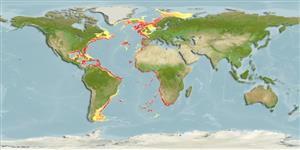Environment: milieu / climate zone / depth range / distribution range
Écologie
marin bathydémersal; profondeur 45 - 1300 m (Ref. 5951), usually 300 - 823 m (Ref. 5951). Deep-water
Western Atlantic: coasts of Canada and United States, Gulf of Mexico, Caribbean, and the coast of South America to Rio de Janeiro, Brazil; in the east, from the Gulf of Guinea to Angola.
Taille / Poids / Âge
Maturity: Lm ? range ? - ? cm
Max length : 39.4 cm TL mâle / non sexé; (Ref. 5951); common length : 14.5 cm SL mâle / non sexé; (Ref. 4490)
Épines dorsales (Total): 0; Rayons mous dorsaux (Total): 5-7; Épines anales 0; Rayons mous anaux: 4; Vertèbres: 18 - 19. Tubercles (its form of scales) have ridges radiating from the apical spine; these ridges heavily edged with spinules, especially the largest tubercles; thus, tubercles appear to be multi-spined. Vertebral count usually 18. Cephalic lateral-line counts: subopercular 4-6, preopercular, 1-3. Tail lateral-line counts 9-13. Usual number of dorsal fin rays 6, pectoral fin rays 14-15; vertebrae 18. Color differences observed between eastern and western Atlantic populations; specimens from Gulf of Guinea often have reticulate markings on the dorsal surface of the body, usually vague (occasionally strong), which are not seen in western Atlantic material. Fins, except dorsal, usually have tubercles on bases of rays. Pectoral fins slender, sturdy relative to most other species; pelvic fins slender (Ref. 40826).
Found on mud or sand-mud bottoms (Ref. 26999). Benthic adults are luminous (Ref. 40826). Feeds chiefly on polychaetes; bottom-living amphipods, bivalve molluscs, brittle stars, starfishes and sea spiders (Ref. 5951).
Life cycle and mating behavior
Maturité | Reproduction | Frai | Œufs | Fécondité | Larves
Bradbury, M.G., 1999. A review of the fish genus Dibranchus with descriptions of new species and a new genus, Solocisquama (Lophiiformes, Ogcocephalidae). Proc. Calif. Acad. Sci. 51(5):259-310. (Ref. 40826)
Statut dans la liste rouge de l'IUCN (Ref. 130435)
Menace pour l'homme
Harmless
Utilisations par l'homme
Pêcheries: commercial
Plus d'informations
Noms communsSynonymesMétabolismePrédateursÉcotoxicologieReproductionMaturitéFraiRassemblement de ponteFéconditéŒufsDéveloppement de l'œuf
RéférencesAquacultureProfil d'aquacultureSouchesGénétiqueElectrophoresesHéritabilitéPathologiesTraitementNutrientsMass conversion
CollaborateursImagesStamps, Coins Misc.SonsCiguateraVitesseType de nageSurface branchialeOtolithesCerveauxVision
Outils
Articles particuliers
Télécharger en XML
Sources Internet
Estimates based on models
Preferred temperature (Ref.
123201): 3.2 - 13.9, mean 8.2 °C (based on 646 cells).
Phylogenetic diversity index (Ref.
82804): PD
50 = 0.5001 [Uniqueness, from 0.5 = low to 2.0 = high].
Bayesian length-weight: a=0.01479 (0.00517 - 0.04233), b=2.93 (2.69 - 3.18), in cm total length, based on LWR estimates for this (Sub)family-body shape (Ref.
93245).
Niveau trophique (Ref.
69278): 3.4 ±0.42 se; based on food items.
Résilience (Ref.
120179): Faible, temps minimum de doublement de population : 4,5 à 14 années (Preliminary K or Fecundity.).
Fishing Vulnerability (Ref.
59153): Low to moderate vulnerability (29 of 100).
